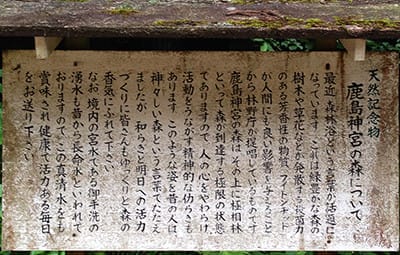



日本列島というのは縄文海進などの地形変化が常態化していた国土だということがだんだん明確になってきている。大陸や半島国家とはまったく違う「土地・風土」概念なのだということに気づかされるようになってきている。
現代わたしたちが普通に平野部と認識している地域は、一皮めくれば海浜であり、刻々と「海退」が進んでいって、その結果表れてきた国土景観ということなのでしょう。この鹿島周辺地域は縄文貝塚と同時に丸木舟の出土も多く、古くから重要な交通路地域だったと考えられている。
とくに現代日本の中心である東京・関東圏、そして大阪などの関西圏もそのようであり、そういう国土の劇的な変容が人間活動の歴史段階にも大きな影響を与えていた。秀吉が関東に移封した家康に対して、このあたりを埋め立ててこのように利用すれば、物流水運的に非常に有用な領土になると推奨したという説話があるけれど、それくらいの歴史時間でも旺盛に国土変容が繰り返されていた。
この鹿島神宮の立地は、人為的な土木ではなく自然が目に見えるように変容し、その様子を見て人間が土木営為で加速させたという日本人の国土利用の経緯を教えてくれている。
鹿島神宮周辺には上の写真のような水郷風景が近隣にいまでも存在し続けている。そういった地の環境に対して列島としての高温多湿の気候条件が豊かな森林地帯を作って行った。

この「鹿島の森」樹叢〜じゅそう〜は茨城県の天然記念物指定を受けているほどに南限・北限の植物類が同生する植物学上、貴重な森だとされている。神域およそ70haに繁茂している植物種は高木から下草に至るまで多種多様1000種にわたるということ。スギ・ヒノキ・スダジイ・タブ・サカキ・モミなど常葉樹、落葉樹の宝庫の自然。そういった自然保護も、日本史のはじめ時期からここが「神々のいます」神域として大切に保全されてきたことが大きく寄与してきた。
また野鳥の数も多く、鹿嶋鳥獣保護区、鹿嶋特別保護地域にも指定されている。縄文以来の海浜・貝塚集落適地として「御手洗池」という湧水適地でもある。
縄文の時期からこの地はいかにも「涅槃にいちばん近い」神宿る地という認識が列島人に広がっていたことは容易に想像できる。逆に言えば、そういう地であるからこそ、祖先のひとびと、神々はこの地を聖なるエリアとして列島社会のすべての人に記憶させ続けてきたのだろう。
翻って、北海道神宮と周辺散策を毎朝の日課としている北海道人としては、いやいや、札幌円山のふもとの豊かな森林環境も、負けずに未来に向かってより豊かに残していきたいと、勝手にムラムラとやる気をみなぎらせておりました(笑)。先人に教えられて、現代北海道もがんばりたい。
English version⬇
Kashima, the Nirvana of Water Villages and Forests: Exploring the Three Shrines of Eastern Japan-5
The natural environment has continued to visibly transform the archipelago's society throughout the historical ages. Perhaps there is something deeply imprinted in the spiritual climate of the Japanese people. ...
It is becoming clearer and clearer that the Japanese archipelago is a land where topographical changes such as the Jomon sea advance were the norm. We are beginning to realize that the concept of "land and climate" is completely different from that of continental or peninsular nations.
The area that we now recognize as a plain is, on the other hand, a seaside beach, and the "retreat of the sea" has been progressively progressing, resulting in the appearance of a national land landscape. In this area around Kashima, there have been many Jomon shell middens as well as many excavations of marukibune (wooden boats), and it is thought that this area was an important transportation route area from ancient times.
In particular, the Tokyo-Kanto area, which is the center of modern Japan, and the Kansai area, including Osaka, were like that, and such dramatic transformation of the national land had a great impact on the historical stage of human activities. There is a story that Hideyoshi recommended to Ieyasu, who had moved to the Kanto region, that if he reclaimed this area and used it in this way, it would be a very useful territory in terms of distribution and water transportation.
The location of the Kashima Jingu Shrine shows us how the Japanese used the land, not through artificial civil engineering, but through the visible transformation of nature, which was then accelerated by human civil engineering activities.
In the vicinity of Kashima Jingu Shrine, suigo landscapes such as the one in the photo above continue to exist even today. The hot and humid climatic conditions of the archipelago against such a local environment created rich forested areas.
This "Kashima Forest" is designated as a natural monument by Ibaraki Prefecture, and is considered to be a valuable botanical forest where plants from both the southern and northern limits of the island grow together. The 70 hectares of the sacred area is home to 1,000 species of plants ranging from tall trees to undergrowth. The nature is a treasure trove of evergreen and deciduous trees such as cedar, cypress, sudajii, tabacum, sakaki, and fir. The fact that this area has been carefully preserved as a sacred place for the gods since the beginning of Japanese history has contributed greatly to the preservation of this nature.
The area is also home to a large number of wild birds, and has been designated as the Kashima Bird and Wildlife Sanctuary and the Kashima Special Protection Area. It is also a suitable site for fresh water called "Mitarashi Pond," which has been a suitable site for seaside and shell mound settlements since the Jomon period.
It is easy to imagine that the people of the archipelago have been aware of this place as a place where the gods dwell, the closest place to nirvana, since the Jomon period. Conversely, it is precisely because it is such a place that the ancestors and the gods have continued to remember it as a sacred area for all people in the archipelago.
As a Hokkaido native who makes it a daily routine to take a walk around the Hokkaido Shrine and its surroundings every morning, I was feeling horny and motivated to preserve the rich forest environment at the foot of Maruyama in Sapporo for the future, as well (laugh). I would like to learn from my predecessors and do my best in modern Hokkaido as well.



















